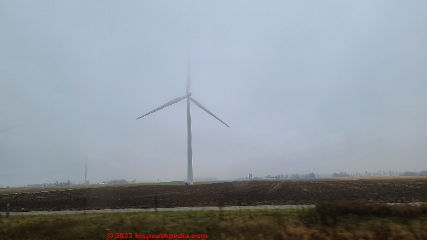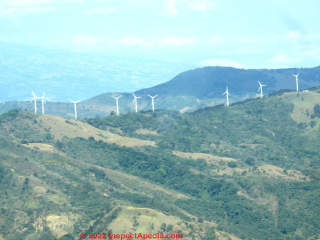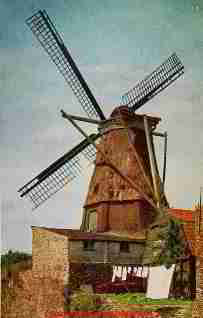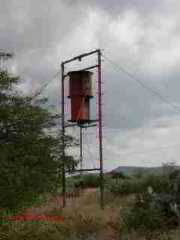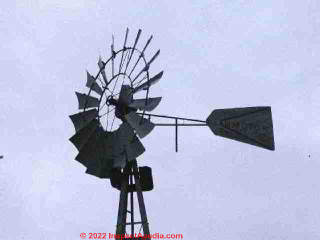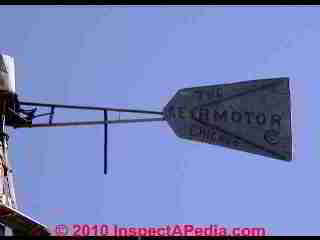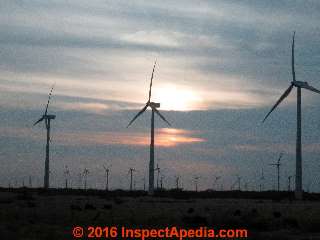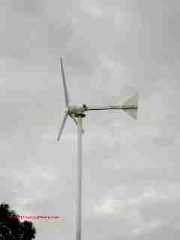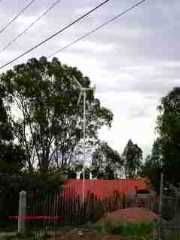 Wind Turbines & Wind Generator Systems
Wind Turbines & Wind Generator Systems
Homeowner's guide to renewable energy systems: wind
- POST a QUESTION or COMMENT about buying, installing, using, maintaining wind energy systems: wind turbines
Wind generator guide for homeowners:
This article describes common types of windmills used for water pumping and electrical energy generating, from Cretan wind sails to Dutch Windmills to modern wind turbine electrical generator systems.
Our page top photo shows a wind generator installed by Aero-Solar in San Miguel de Allende, Mexico where by 2010 many local solar & wind power companies offered wind turbine and solar power generation installation services.
InspectAPedia tolerates no conflicts of interest. We have no relationship with advertisers, products, or services discussed at this website.
- Daniel Friedman, Publisher/Editor/Author - See WHO ARE WE?
Wind Energy Systems & Wind Turbine Controls & Circuits
What is Wind Energy and How is Wind Power Generated?
Photo: small wind-powered generator at Salida Queretaro, San Miguel de Allende, Guanajuato, Mexico.
[Click to enlarge any image]
According to the Pennsylvania DEP who provide a brief introduction to wind power, wind energy systems are mechanical or electro-mechanical equipment that turn the force of moving air (wind) into mechanical energy (such as operating a mechanical pump to lift water from a well into a reservoir) or into electrical energy (operating a wind turbine or motor that converts the rotation of a wind-turned shaft into electrical energy). The text below is adapted from that source:
Wind power, in its most basic form, is taking the breezes and winds that you feel on your face or that cause a flag to flap and converting it into energy that can be used in other processes.
The sail on a boat is among the most common examples. When wind hits the sail, it's converted into motion that carries the craft over the water.
Below: The blades on these wind turbines in Metcalfe Ontario are so huge that they disappear into the morning mist. (October 2022)
Here for reasons of historic interest we include wind-operated mechanical windmills that traditionally were used as water pumps or to mill grain. But consonant with modern interests, our focus is on using wind for electricity generation.
Electrical energy is produced from wind by wind turbines mounted on towers, similar to the small unit in the photographs shown on this page.
On a wind turbine, the large blades, or rotor, of the turbine capture the wind's energy and begin turning.
The wind turbine rotor, rotating as the blades are pushed by the wind, drives a shaft inside the nacelle (shell) of the wind-turbine (or electricity-generating motor that is located directly behind the blades). The nacelle contains the drive train (including the electrical generator).
The rotor and nacelle rest on top of a tower that can range from 30 feet to over 200 feet tall. The remainder of the turbine consists of equipment to control the turbine and connect it to the electricity grid so that the power can be used.
Above: a row of wind turbines in service in Costa Rica (2018).
Wind speed is an important variable in determining how much electricity a turbine produces. The energy in wind is a cube of its speed. A wind speed of 11 miles-per-hour will produce 30 percent more energy than a wind speed of 10 miles-per-hour. Areas of the commonwealth have received different classifications based on wind speed.
To see the wind speed for your area, check out wind speed maps for your local area. In PA wind speed maps are provided by the PA DEP.
Modern wind generators (such as the small model shown in our page to photo) use advanced propeller designs whose blades maximize lift and minimize drag.
Some propellers bend in high winds to avoid overspeed or damage. Both two-bladed and three-bladed propellers are used. On large wind generators the propellers may be more than 125 feet in diameter.
Above: wind generators at a wind energy generating station on the coast of Oxaca, Mexico in the Isthmus area of Southern Oxaca.
In January 2010 the New York Times reported that the U.S. is close to producing 2 percent of its electricity from wind turbines, and that wind power production grew in the United States during 2008 and 2009 by a total of 57%. [2008 (18%) and 2009 (39%)]., adding 9,900 megawatts of electrical energy in 2009 alone (according to the American Wind Energy Association).
Rate of Growth of Wind-Generated Energy
In 2010, experts anticipated tyat by 2020, energy derived from wind power was expected to be about 180,000 megawatts. -- NY Times 1/26/2010.
In fact progress has been faster than hoped. The U.S. Office of Energy & Renewable Energy reported that "the U.S. installed a record of 17 GW of new wind capacity in 2020, bringing the cumulative total wind generated electrical power to 122 GW or Gigawatts. (1 GW = 1000 MW.)
A record 16,836 megawatts (MW) of U.S. wind capacity was installed in 2020, bringing the cumulative total to 121,955 MW. Wind power installations outpaced those in solar power for the first time in several years and represented $24.6 billion of investment. Wind provides more than 10% of electricity in 16 states, and over 30% in Iowa, Kansas, Oklahoma, South Dakota, and North Dakota.
Improvements in the cost and performance of wind power technologies, along with the Production Tax Credit, have driven wind energy capacity additions, yielding low-priced wind energy. Wind turbines continued to grow in size and power, with the average nameplate capacity of newly installed wind turbines at 2.75 MW—up 8% from 2019 and 284% since 1998−1999.
The combined health, climate, and grid-system benefits of wind are almost 3 times its levelized cost of energy.
- LAND BASED WIND MARKET REPORT, 2021 Ed. [PDF] U.S. Department of Energy, Oak Ridge TN.
Use of wind power and its increased growth may help reduce emissions of gases that cause the increasingly rapid worldwide problem of global warming. In January and February 2010 the New York Times reported that most of the wind turbines and wind energy being installed in the U.S. as well as most of the solar panels being used in the U.S. are being produced in China, and that G.E. (General Electric) makes nearly half the wind turbines used in the United States. U.S.
Most of this wind power growth was in large wind turbines delivered to wind farms primarily in Texas, Iowa, California, Washington, and Minnesota, and aided by President Obama's economic stimulus package.
Put in context, this was about the same amount of energy production increase in the U.S. as was provided from growth in production of natural gas, and the combination of those two energy sources accounted for 80% of all new electricity generation capacity in the country. By 2020, experts report, energy derived from wind power could be about 180,000 megawatts. - The New York Times 1/26/2010.
Floating Windmills: Interesting wind power developments in 2014 included Japan's construction of a new 350 ft. high wind-generating station 12-miles off Japan's cost near the (radioactive leaking) Fukushima nuclear reactor station. The project intends to construct 140 wind turbines and to be capable of generating a gigawatt of electricity by 2020. - The New York Times 10.25.13
Examples of Wind Generators & Windmills for Power Generation or Water Pumping
Traditional Dutch Windmills and Vertical Axis Wind Powered Water Pumps
The Dutch windmill (below left) is a traditional horizontal-axis slow-speed windsail - suitable for pumping water. The split-barrel windmill (below right) is a low-cost home-made water pump system.
Antique horizontal axis Dutch windmills
Our photos show two wind power systems: the old four-arm classic windmill on the city rampart at Montfoort, Holland (far left).
Four-arm slow-speed windmills had propellers as large as 100' in diameter. Some have been converted to production of electrical energy, producing as much as 8 KWH in 20 mph. winds.
Vertical axis windmills
A home-built vertical-axis barrel rotor wind energy system in El Charco, in San Miguel de Allende, Mexico is shown here.
The vertical axis windmill has the advantage that it does not have to be oriented towards wind-direction.
The slow axis speed and the 20% efficiency of the split barrel design means that like the Dutch windmill above, these two wind energy systems are most often suitable for water pumping applications.
Other more efficient vertical axis windmill designs have been used or experimented with since the 1930's in the U.S., including the Darrieus vertical-axis rotor that looks like an oval embroidery hoop to a wind power novice.
Vertical axis wind turbines (in the 1970's) were not self-starting and needed an electric motor to begin activity.
Alternative vertical axis wind generator designs include the variable-pitch Cyclo-turbine (4KW at 25MPH wind) and a double-rotor helical wind generator.
Sail Windmills
Other than the Dutch traditional windmill (above left) originated in Crete and other Mediterranean countries where they have been used for water pumping for generations, a Cretan sail windmill is also a slow-speed system (tip speed ratio 0.75:1) but this inexpensive wind system is made of wood and sailcloth, turning at a maximum of about 50 rpm. In high winds the sails are reefed.
Sail windmills for electrical energy have been produced as home-made systems capable of generating about 200 watts at 15 mph winds. - McGuigan.
Multi-blade Windmills or "Fans" used for Pumping Water
Our page top photo shows a multi-blade water pumping windmill in use in Guanajuato, Mexico - these fans have been in widespread use in North American since the 1800's where on ranches and farms they have been used to produce water for both human and livestock use.
Water Pump Windmills: Photos of Windmills Used as Well Pumps & The Aer-Motor Windmill Company of Chicago, IL

The windmill in our photograph was used for decades to pump water into a local reservoir tank for distribution in the Atascadero neighborhood of San Miguel de Allende, Mexico.
For speed control traditional windmills of this type were able to adjust the direction of the tailpiece to divert the fan blades from the oncoming wind direction if wind speed was excessive.
This windmill was built by the Aer-Motor Windmill Company (of Chicago, IL in our photo, presently in Texas), and served as a water source for decades. Aer-Motor Windmill has been producing windmills since 1888.
Below our photo shows a close up of the windmill top, showing the company's name and "Chicago" on the tail.
Quoting from the Aer-Motor Windmill company's literature,
Aermotor Windmill has a very interesting 118 year business history. However, one simple truth stands undiminished by time or geography.
Aermotor Windmill has continuously manufactured windmills since 1888 and is the only windmill manufacturer in the USA. There is only one genuine Aermotor windmill.
Aer-Motor windmills are still produced and are available with wheel diameters from 6' to 16' and on towers from 21' to 60' in height.
Water pump windmills of this type use a cylinder pump operated by an eccentric crank. As the windmill wheel rotates the eccentric crank raises and lowers a rod. At the bottom of the rod a cylinder pump lifts a column of water from the bottom of the well up into a water reservoir.
Recently this water mill was converted to use an electric water pump instead of the windmill and the wind machine has been retired, remaining principally as a local landmark. Here is a photograph of the pump motor used to convert this water source to electric rather than wind power.
Wind Generator Rotor Speed Control
Rotor or Sail Speed Governors are required on all high-speed wind generators and pumps to avoid both damage and danger from excessive rotor speeds that otherwise occur in high winds.
The windmill in our Aer-Motor water pump windmill photograph (above left) was used a hinged tailpiece or rudder to either face the wheel into the wind or in high winds, to "feather" the wheel at right angles to the wind to reduce or stop its rotation.
For speed control traditional windmills of this type were able to adjust the direction of the tailpiece to divert the fan blades from the oncoming wind direction if wind speed was excessive.
What are Typical Wind Generator Towers & Turbine Heights
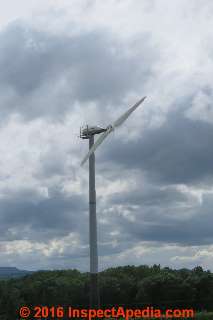
Above: a wind turbine installation in Herefordshire, England. Unlike the huge Oxaca wind turbine farm illustrated in other photos on this page, walking through Herefordshire we were more likely to find individual, isolated wind-turbine installations.
Tower height makes the most significant difference in wind generator output [taller is better], while site selection may be similarly important in avoiding turbulence or blocked winds.
Wind energy system heights vary significantly, from small rooftop mounted units on buildings in some areas, to common wind farm turbine heights of 80 meters (263 feet) to the turbine or, depending on blade length, a total height of about 112 m (370 feet) above ground.
Proven Energy who produce small scale wind turbine systems provides system masts are 11m (36 ft) and 15m (50 ft) tall.
Life Expectancy & Noise of Wind Generators & Turbines
Above: wind generators at a very large wind energy generating station on the coast of Oxaca, Mexico. Located in a famously windy area on the Oxacan coast, these towers were, to my ear, very quiet even on a particularly windy day. This is an area of high winds and low population density.
The expected life of any renewable power source will vary by many factors, as we list and describe here.
We collect and describe some of them here, and we develop a chart of trends in the anticipated life of wind generators by age, type, etc.
In a casual inspection of several kilometers of wind turbines as we drove along the coastal highway in the Isthmus area of Mexico (Southern Oxaca) it was easy to spot a few turbines that apparently had had lubrication issues, such as the unit above, an Acciona wind turbine.
Subjectively it looked as if about 5% of the turbines were not in operation. Interestingly, lubrication failures were not among the common wind turbine life expectancy factors I found when researching industry sources.
Current estimated life for modern wind generator turbine designs range from 20 to 30 years. Here are some wind generator life estimate sources:
- NWEA: 20 years
- Proven Energy, UK: 20 - 25 years, extendable to 40 years with turbine refurbishing. Quoting:
Proven Energy wind turbines [3.2kW, 6kW and 15kW] have an estimated life and design expectancy of around 20-25 years.
Throughout this time, the turbine may need some parts replaced, similar to replacing parts in a car throughout its lifetime. Regular servicing and maintenance will ensure that your wind turbine will have the best chance of achieving or even exceeding its life expectancy.
- National Wind: 20 to 30 years
But there can be considerable variation in both wind system life and its operating cost, depending on the factors we list below.
Factors Affecting Wind Energy System Life & Operating Costs
According to Mick Sagrillo, Sagrillo Power & Light , writing for AWEA, factors affecting and improving the typical (in 2010) 20-year life expectancy of a wind energy system include:
- The level of wind turbine system maintenance performed by the system owner
- The use of simple wind generator or turbine designs [fewer parts, easy maintenance]
- Wind generator motor design - see WIND GENERATOR MOTORS - Evolution of Efficiency, Reduction in Noise below.
- Improvements in materials used in component parts of wind generators improving weather resistance and resistance to wear on moving parts:
- stainless steel fasteners
- metal alloys for turbine bodies
- improved generator motor bushing materials [cited by several sources],
- turbine blade components [carbon reinforced fiberglass, plastics, epoxy composites, UV-resistant tapes on turbine blade leading edges]
- alternator /generator motor insulating material improvements
- paint coatings with improved weather resistance
- Exposure to wind borne dust, insects, debris
- Exposure to rain, moisture, severe weather, storms
- Sun exposure
- Direct drive (fewer moving parts) vs. gearbox drive (more moving parts) design
- Risk of lightning strike -
see WIND TURBINES & LIGHTNING - Adequacy of supporting tower for the site and for the turbine it supports.
A wind generator tower that is too-short means more wear as the rotor turns to hunt for wind - see our next wind generator photo below - while tall towers involve extra cost, more wind stress on the structure, noise, bird interference, visual interference and other concerns.
See WIND TURBINE HEIGHT.
According to Proven Energy who describes the annual service for a modern wind generator,
The servicing procedure is very simple - once a year, the turbine is lowered to ground level (using the hinged tower), the covers are removed and a full service of parts is conducted before the tower is raised and secured.
Commonly-cited wear parts on wind generators include:
- Alternator bearings1
- Yaw bearings1
- Blade edges or blades1
- Tail bushings2
- Slip rings2
- Alternator brushes2
- Wind speed governor components
- Gearbox lubricant (for models using gearboxes rather than direct drive)
1 = significant costs to repair/replace
2 = usually minor maintenance cost items
Typical Maintenance Costs for Wind Energy Systems
AEWA recommends that while wind system maintenance and repair costs will not be uniformly distributed over the life of the system, installers should allocate one percent of the installed cost of a wind energy system [per year] for operation and maintenance expenses over the life of the system.
For wind generators using a gear box drive rather than direct drive generators, annual gear box lubrication changeout doubles the estimated maintenance cost.
Wind Generator Motors - Evolution of Efficiency, Reduction in Noise
Early electrical generators using wind power operated using a copper-wound electric motor and carbon-arc brushes.
Older wind energy texts such as McGuigan point out that the life expectancy of early motor generators was quite variable, from 20 years to just a year or so. Modern wind generators and turbines use alternators, eliminating the brush design, combined with a AC to DC rectifiers to produce DC electrical energy that is stored in batteries.
The New York Times, describing the wind and solar energy project in Tocco de Casuaria, in central Italy, reported (29 Sept 2010) that Tocco was chosen for an early European Union wind power demonstration project in 1989.
"It had two inefficient wind turbines installed that lasted about a decade (half the wind turbine life expectancy in 2010) and were not replaced, meeting at best 25 percent of the town's electricity requirements.
According to the Times, Residents called the 1989 wind power installations 'sacks of noise' ". The Times article pointed out that recent improvements in wind turbine technology, quiet motors, and increasing costs for electrical energy prompted Tocco de Casuaria, to take a second look at wind power.
Tocco (population 2700) installed two new wind turbines in 2007 and two more in 2009, now producing more electrical energy than the town consumes, and joining more than 800 Italian communities producing more energy than they consume.
Wind Generator or Turbine Noise Factors
According to National Wind, the following factors affect the [human-perceived] noise produced by wind energy systems:
- Engineering design of turbines and blades.
- Turbine model
- Wind generator blade design
- Setback or distance from homes (typically 1000 to 1500 feet from homes meet noise standards
National Wind describes the perceived noise of a modern wind generator installed to current standards as about that of a typical kitchen refrigerator. [We note that the noise of refrigerators itself varies quite widely depending on motor type, motor location, sound insulation, and fan use - Ed.]
Wind Generator Tower Height & Tethered Lighter-than-Air Wind Generators
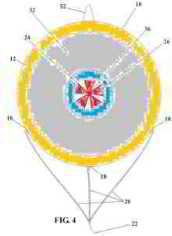 The relationship between wind generator power and wind speed is stated as
The relationship between wind generator power and wind speed is stated as
P = 1/2 d AV3
where P is power available at the turbine rotor, d is the density of the air, A is the swept area of the rotor, and V is the wind speed. At any given location, we have no control over air density, and for a given wind generator with the rotor diameter it was bestowed with, the only real variable is V, wind speed.
Therefore, we can rewrite the equation to say P~ V, or more appropriately P~V3. ... taller towers result higher wind generation. The reason is reduced ground drag. As you get away from the surface of the earth, ground drag (or friction) on the wi nd decreases, and V goes up. V3 amplifies that increase - Sagrillo (2005)
Illustrated at left is a sketch of a lighter-than-air wind turbine generator adapted from patent illustrations from Amick (2008).
Sagrillo continues to note that at comparatively lower wind generator tower heights common in 2005, [and probably as a general rule] increasing an example tower's height (for example studying data for a wind tower in North Dakota), from 42 feet to 84 feet increased the wind generator's available power by 188%.
In a different example using a home-wind energy site in Illinois Sagrillo notes that increasing a tower height from 30 feet to 120 feet found an average wind speed increase of just 3 mph produced a 215% increase in available power.
What about achieving much higher effective wind generator heights than those practical with physical towers? In a wind industry development worth watching, in March 2014 The New York Times reported on the Buoyant Airborne Turbine or "BAT", a helium-filled donut-shaped wind turbine under development by Altaeros Energies who are testing an airborne wind turbine in Alaska.
The Times article noted that wind turbines atop towers 300 to 400 feet high in Michigan, Ohio, and Indiana are able to produce electrical power at rates competitive with coal as an energy source - at prices close to $0.04 per kilowatt hour.
The Buoyant Airborne Turbine - BAT, in comparison, is designed to operate at a height of around 1000 feet, feeding its generated power to the ground through its tethering cable. The helium-supported BAT is designed to operate in high winds (100+ mph), to tolerate heavy precipitation, and to protect its equipment from lightning surges. In severe conditions the generator can be lowered and docked.
Another airbourne wind generator project is the winged turbine wind generator under development by Makani Power that "flies in circles".
Tethered airborne wind generator designs promise the advantage of the ability to adjust the operating height of the turbine to changing wind conditions, and a perhaps a second advantage of portability, permitting emergency power generation in disaster areas.
The helium-lofted BAT can be deployed in a day and requires no crew for day to day operation. - The New York Times, Cardwell (2014) & Altaeros Energies website retrieved 3/24/2014
Lighter-than-Air Wind Energy Systems
- Altaeros Energies, Email: info@altaerosenergies.com, Website: http://www.altaerosenergies.com/
- Amick, Douglas J. "Tethered Wind Turbine." U.S. Patent Application 11/830,769. US 20080048453 A1, 2/28/2008
Abstract
The tethered wind turbine uses an aerodynamic, flow-concentrating shape and lighter-than-air construction utilizing a lifting gas and an electrically conductive tether fixed to ground to reap energy from the wind at low or high altitude.
The design has no need for the large, expensive, bulky and unsightly tower structures, pivoting nacelles, or gearboxes presently used in conventional horizontal axis windmills. The tethered wind turbine of this invention easily and passively floats aloft downwind to a direction and position that is aligned with the wind.
The invention uses sensors and control modules to fly gracefully at an optimal altitude in most wind regimes and also to ascend/descend when appropriate to seek shelter from extreme weather conditions. Ideally, the tethered wind turbine of this invention would utilize carbon nanotube materials in its tether for both structural and conductive purposes.
The ring-wing section profile in the preferred embodiment of this invention optimally would have a very low coefficient of drag. A major benefit of this invention is potentially much lower cost per installed kilowatt capacity and a lower operating cost per kilowatt hour delivered to the end user. - Civalier, Gordon, et al. "Comparative Analysis of Three Concepts for Aerostat Based Electrical Power Generation System." 11th AIAA Aviation Technology, Integration, and Operations (ATIO) Conference, including the AIAA Balloon Systems Conference and 19th AIAA Lighter-Than. 2011.
- Danish Wind Energy Association, "Wind Shade Calculator", – http://www.windpower.org/en/tour/wres/shelter/index.htm
- Gipe, Paul, "Wind Power - Renewable Energy for Home, Farm, an Business", [citation details needed].
- Hembree, B., Slegers, N.: Tethered Aerostat Modeling Using an Efficient Recursive Rigid-Body Dynamics Approach. Journal of Aircraft 48(2), 623–632 (2011). doi: 10.2514/1.C031179
- Rivard, P.: Magenn Power, Inc. - Wind Power Anywhere. Presented at the Airborne Wind Energy Conference 2010, Stanford, CA, USA, 28–29 Sept 2010. http://www.awec2010.com/public/presentations/rivard_pierre.pdf
- Sagrillo, Mick, "Zoning for Small Wind: the Importance of Tower Height, an ASES Small Wind Webinar", presentation (2008), U.S. Department of Energy (DOE), Stakeholder Engagement & Outreach, retrieved 3/24/2014, original source: http://www.windpoweringamerica.gov/pdfs/workshops/2008/sw_zoning_tower_height.pdf
- Sagrillo, Mick, "The Wind's Power at Various Tower Heights", Sagrillo Power & Light, Windletter, American Wind Energy Association, Vol. 24, No. 12, December 2005
- Stanney, K. A., Rahn, C. D.: Response of a tethered aerostat to simulated turbulence. Communications in Nonlinear Science and Numerical Simulation 11(6), 759–776 (2006). doi: 10.1016/j.cnsns.2005.01.001
- Vermillion, Chris, Ben Glass, and Adam Rein. "Lighter-Than-Air Wind Energy Systems." Airborne Wind Energy. Springer Berlin Heidelberg, 2014. 501-514.
Abstract
Several wind energy concepts utilize airborne systems that contain lighterthan-air gas, which supplements aerodynamic lift and expands these systems’ available operating regimes.
While lighter-than-air systems can incorporate the traction and crosswind flight motions of their heavier-than-air counterparts, several lighterthan-air concepts have also been designed to deliver large amounts of power under completely stationary operation and remain aloft during periods of intermittent wind.
This chapter provides an overview of the history of LTA airborne wind energy concepts, including the design drivers and principal design constraints. The focus then turns to the structural and aerodynamic design principles behind lighterthan air systems, along with fundamental flight dynamic principles that must be addressed.
A prototype design developed by Altaeros Energies is examined as an example of the application of these principles. The chapter closes with suggestions for future research to enable commercially-viable LTA systems. - Widnall, S.: Potential Flow Calculations of Axisymmetric Ducted Wind Turbines, Massachusetts Institute of Technology, 2 Sept 2009. http://dspace.mit.edu/handle/1721.1/46707
Other Wind Generator & Wind Energy System Concerns
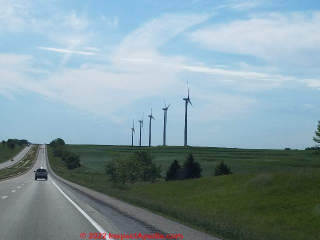 Photo: Wind turbines line the highway in Kansas (2018) - DF.
Photo: Wind turbines line the highway in Kansas (2018) - DF.
Wind Energy System Payback Time: according to Provez Energy,
Payback time [to return the original installation cost of a wind energy system] varies dependent on the wind regime, grants, incentives, existing energy consumption and costs.
The standard timescales are between three and ten years. If you look at this as a percentage return it works out at a minimum of 12% year on year over the life 25 year of the product.
Wind Energy Tower Shadow flicker: excessive shadow produced by the wind turbine rotor in bright sunlight - depends on latitude, sun angle, and perceived shadow dependence on wind tower setbacks from homes
Wildlife impact of wind energy systems: according to National Wind,
According to a report released by the National Academy of Sciences in May of 2007, 20,000-30,000 birds, less than one percent of a total of one billion, died as a result of colliding with wind energy facilities.
One reason modern towers are solid tubes and not lattice towers, is to prevent birds from trying to nest on the turbines.
Wind turbine electrical generators & Wind Generator Controllers, also packaged solar generators
- CVI, Chaul Valve, Inc., ENERGÍA EOLICA, at http://www.chaul.net/genpro.htm - photographs of wind turbines ranging from 300W to 20,000 Watts. Generador de Turbina = 20kW
- Proven Energy, Wardhead Park, Stewarton, Ayrshire, KA3 5LH, Scotland, UK, Tel: 01355 597 000, Web: http://www.provenenergy.co.uk/ / The Torus Building, Rankine Avenue, Scottish Enterprise Technology Park, East Kilbride G75 0QF. Registered in Scotland No: 71400.
Proven Energy is a Scotland producer of wind energy systems, small scale wind power provider in 60 countries - Sunforce 44444 12-Volt 400-Watt Wind Generator,
The Sunforce 44444 400 Watt Wind Generator uses wind to generate power and run your appliances and electronics. Constructed from lightweight, weatherproof cast aluminum, this generator is also a great choice for powering pumps or charging batteries for large power demands. With a maximum power up to 400 watts or 27 amps, this device features a fully integrated regulator that automatically shuts down when the batteries are completely charged. T
The 44444 is virtually maintenance free with only two moving parts, and the carbon fiber composite blades ensure low wind noise while the patented high wind over speed technology guarantees a smooth, clean charge.
Assembly is required, but this generator installs easily and mounts to any sturdy pole, building, or the Sunforce 44455 Wind Generator 30-Foot Tower Kit. The 44444 uses a 12-volt battery (not included) and measures 15 x 9 x 27 inches (WxHxD). - Windpower generator and tower, Sunforce products Solar Wind Power Tower- AIR-X Land wind turbine/ 10 Watt, AEE, SW Windpower, Samlex, Morningstar
Books & Articles Wind Generators and Wind Energy System Designs
 Photo: Wind turbines at Macinac Point, Michigan (2018).
Photo: Wind turbines at Macinac Point, Michigan (2018).
- ANSI/ISO, Environmental Management – Life Cycle Assessment – Principles and Framework (ISO 14040-1997), NSF International, Ann Arbor, MI, 1997.
- Developing Wind Power Projects: Theory and Practice, Tore Wizelius, Earthscan Publications Ltd. (January 2007), ISBN-10: 1844072622, ISBN-13: 978-1844072620
Wind power is developing rapidly, both in the number of new installations and in the interest from various stakeholders including policy makers, NGOs, research scientists, industry, and a broader general public.
Unlike the majority of other texts on wind power, which are written primarily for engineers or policy analysts, this book specifically targets professionals and students interested in wind power project development.
Having outlined wind power basics and explained the underlying resource and technology, the author explores the interactions between wind power and society and the main aspects of project development, including, siting, economics, and legislation.
Based on a successful Swedish edition, expanded and updated for an international market, this book will be an essential reference for professionals developing new sites, government officials and consultants reviewing related applications, and both specialists and non-specialists studying wind power project development. - Harnessing the Wind for Home Energy, Dermot McGuigan, Garden Way Pub Co (February 1978), ISBN-10: 0882661175, ISBN-13: 978-0882661179 - old text, brief, concise, helpful - DF
- Induction Generators for Wind Power, Vladislav Akhmatov, Multi-Science Publishing Co. Ltd. (August 1, 2007), ISBN-10: 0906522404, ISBN-13: 978-0906522400
[Quoting]
At a time of great concern about energy efficiency and the future of energy supply comes an in-depth look at the technical aspects of producing wind power. The complexities of converting wind power into electricity that can be readily distributed through national power lines are discussed.
This book analyzes a full range of simulated induction generators and grid conditions, and electrical engineering theory is also presented. - Natural Energy Association Windpower Booklet: Practical Guide to Available Wind Generators, Natural Energy Assn, (May 1979), ISBN-10: 0950610720, ISBN-13: 978-0950610726
- The Homeowner's Guide to Renewable Energy: Achieving Energy Independence through Solar, Wind, Biomass and Hydropower (Mother Earth News Wiser Living), Dan Chiras, ISBN13: 9780865715363
The coming energy crisis caused by a peak in global oil and natural gas production will profoundly affect the lives of all North Americans. As the price of these vital fuels rises, homeowners will scramble to cut their fuel bills. Two options for meeting the upcoming challenge are dramatic improvements in home energy efficiency and efforts to tap into clean, affordable, renewable energy resources to heat and cool homes, to provide hot water and electricity, and even to cook.
These measures can result in huge savings and a level of energy independence. The Homeowner’s Guide to Renewable Energy tells you how.
It starts by outlining the likely impacts of fossil fuel shortages and some basic facts about energy. It then discusses energy conservation to slash energy bills and prepare for renewable energy options. Focusing carefully on specific strategies needed to replace specific fuels, the book then examines each practical energy option available to homeowners:
Solar hot water, cooking, and water purification • Space heat: passive and active solar retrofits • Wood heat • Passive cooling • Solar electricity • Wind-generated electricity • Electricity from microhydropower sources • Emerging technologies—hydrogen, fuel cells, methane digesters, and biodiesel
The Homeowner’s Guide to Renewable Energy gives readers sufficient knowledge to hire and communicate effectively with contractors and, for those wanting do installations themselves, it recommends more detailed manuals. With a complete resource listing, this well-illustrated and accessible guide is a perfect companion for illuminating the coming dark age. - The Renewable Energy Handbook, Revised Edition: The Updated Comprehensive Guide to Renewable Energy and Independent Living, William H. Kemp,
This revised edition of The Renewable Energy Handbook focuses on the unique requirements of off-grid living as well as using "green" energy for homeowners who remain connected to the electrical utility. The book contains chapters on:
Energy efficiency and economics * Home heating and cooling and domestic water heating * Photovoltaic, wind, and micro-hydro energy generation * Battery selection and inverters * Backup power, wireless communications, etc.
It includes comprehensive specifications for many of the products available in the market today. Whether you are just curious or an industry expert, this handbook will show you how to stretch your energy dollars (doing much more with less) while powering your home with renewable energy.
And, unlike fossil fuels or nuclear energy, renewable energy frees you from worry about dumping today's pollution on tomorrow's children. Since its release in 2003, The Renewable Energy Handbook has been a top-selling technology book and is recognized as the best in its field.
This edition has been fully revised for 2010 and beyond. It has been increased in size to an easy-to-read 8 x 10 inch format, and it is augmented with hundreds of illustrations, line drawings, photographs, and appendices. - Turbulence statistics for design of wind turbine generators, J. C. Kaimal,
[Quoting]
This volume is produced from digital images created through the University of Michigan University Library's large-scale digitization efforts. The Library seeks to preserve the intellectual content of items in a manner that facilitates and promotes a variety of uses. The digital reformatting process results in an electronic version of the original text that can be both accessed online and used to create new print copies.
The Library also understands and values the usefulness of print and makes reprints available to the public whenever possible. This book and hundreds of thousands of others can be found in the HathiTrust, an archive of the digitized collections of many great research libraries. Access to the University of Michigan Library's digital collections - http://www.lib.umich.edu and for information about the HathiTrust, please visit http://www.hathitrust.org - U.S. Department of Energy, National Renewable Energy Laboratory, Wind energy resource atlas of the United States, DOE/CH-10093-4, hhttp://rredc.nrel.gov/wind/pubs/atlas/atlas_index.html, 1986
- U.S. DOE, LAND BASED WIND MARKET REPORT, 2021 Ed. [PDF] U.S. Department of Energy Office of Scientific and Technical Information P.O. Box 62 Oak Ridge, TN 37831-0062 OSTI: http://www.osti.gov Phone: 865.576.8401 Fax: 865.576.5728 Email: reports@osti.go
- Wind Energy Generation: Modelling and Control, Olimpo Anaya-Lara, Nick Jenkins, Janaka Ekanayake, Phill Cartwright, Michael Hughe, ISBN13: 9780470714331
[Quoting]
With increasing concern over climate change and the security of energy supplies, wind power is emerging as an important source of electrical energy throughout the world. Modern wind turbines use advanced power electronics to provide efficient generator control and to ensure compatible operation with the power system.
Wind Energy Generation describes the fundamental principles and modelling of the electrical generator and power electronic systems used in large wind turbines. It also discusses how they interact with the power system and the influence of wind turbines on power system operation and stability.
Key features: * Includes a comprehensive account of power electronic equipment used in wind turbines and for their grid connection. * Describes enabling technologies which facilitate the connection of large-scale onshore and offshore wind farms.
* Provides detailed modelling and control of wind turbine systems. * Shows a number of simulations and case studies which explain the dynamic interaction between wind power and conventional generation. - In addition to citations & references found in this article, see the research citations given at the end of the related articles found at our suggested
CONTINUE READING or RECOMMENDED ARTICLES.
List of Wind Turbine Generator & Solar Energy Companies, San Miguel de Allende, Mexico Guanajuato
Ace Lab (52) (47) 7740055 Blvd Hidalgo 2006 Col Sn Jos Consuelo Cp 371 Len, GT
- Auto Partes Henry (52) (47) 7710553 Blvd J Torres Landa 6002 Cp 37530 Len, GT
- Aero Solar Mexico, San Miguel de Allende, Mexico,
Carr. San Miguel / Queretaro Km 3,
San Miguel de Allende, Gto. MX Web: aerosolarmexico.com/index1.html
Tel. 415-1500000 / 415-1200000 [generador eolico - see photo at top of this page] email: info@aerosolarmexico.com - Solar energy - Apollo Solar Design, briowen@yahoo.com
- CONSTRUCTORA NOBERGO (415) 152-0747 blvd de la conspiracion 13 SAN MIGUEL DE ALLENDE, GT
- Construcciones Y Excavaciones Del Norte Sa De Cv (52) (47) 7116788 Blvd Torres Landa 5703 Cp 37530 Len, GT
- CIMAQ (415) 150-7216 de la estacion 137 centro SAN MIGUEL DE ALLENDE, GT
- CONST Y TRITURACIONES (415) 120-2169 cll lucero 50 la lejona SAN MIGUEL DE ALLENDE, GT
- Solar energy - DesMex Solar, Carretera a Celaya Km. 1,
Plaza Alhóndiga Local 14 (1M),
Frente a Mega Comercial Mexicana
Alejandra Galiana, info@desmexsolar.com 415 150 7312 - Gas Noel (52) (47) 7182222 Paseo De Los Insurgentes 404 A Jardines Cp 3 Len, GT
- Importexportmexico, wholesale supplier, exporter, importer: water pumping windmills, water filtering and purification systems, wind energy towers and structures (small), remote home power systems. # 1 Montitlan Los Balcones, San Miguel de Allende , GTO Mexico 37720 Tel: 011 52 415 15 4 6947
- Logstica Express (52) (47) 7169986 Ricardo Castro 123 Cp 37480 Len, GT
- RODRIGEZ PEREZ LUIS ENRIQUE (415) 154-7292 durazno 8 la lejona SAN MIGUEL DE ALLENDE, GT
- RODRIGEZ PEREZ LUIS E (415) 154-7292 clle durazno 8 SAN MIGUEL DE ALLENDE, GT
- Solar energy - Solar & Heating Solutions, Javier Hernandez 415 113 9710, javier@mexsolar.com
- Wind & Solar Power - Solar San Miguel - The Green Store, Plaza Conspiracion, Salida Queretaro, Ben-Zion Ptashnik 415 154 6397 or 044 415 153 5164, benptashnik@yahoo.com
- Wind & Solar Power - Soluciones Solares, Enrique Orvaños 415 154 4915 o 415 103 3355; eorvananos@solsol.com.mx
- Wind & Solar Power - Distribuidora Waltho de SMA, Miguel Gil 415 152 8378 o 415 113 9544; distribuidora@gmail.com
...
Continue reading at WIND TURBINES & LIGHTNING or select a topic from the closely-related articles below, or see the complete ARTICLE INDEX.
Or see these
Recommended Articles
- ELECTRIC SERVICE GROUNDING SYSTEM INSPECTION
- ENERGY SAVINGS in BUILDINGS
- LIGHTNING PROTECTION SYSTEMS
- REMOTE ELECTRIC POWER, PHOTOVOLTAIC
- SOLAR ENERGY SYSTEMS
- WIND ENERGY SYSTEMS
- WIND TURBINES & LIGHTNING
Suggested citation for this web page
WIND ENERGY SYSTEMS found at InspectApedia.com - online encyclopedia of building & environmental inspection, testing, diagnosis, repair, & problem prevention advice.
Or see this
INDEX to RELATED ARTICLES: ARTICLE INDEX to BUILDING ENERGY SAVINGS
Or use the SEARCH BOX found below to Ask a Question or Search InspectApedia
Ask a Question or Search InspectApedia
Questions & answers or comments about buying, installing, using, maintaining wind energy systems: wind turbines
Try the search box just below, or if you prefer, post a question or comment in the Comments box below and we will respond promptly.
Search the InspectApedia website
Note: appearance of your Comment below may be delayed: if your comment contains an image, photograph, web link, or text that looks to the software as if it might be a web link, your posting will appear after it has been approved by a moderator. Apologies for the delay.
Only one image can be added per comment but you can post as many comments, and therefore images, as you like.
You will not receive a notification when a response to your question has been posted.
Please bookmark this page to make it easy for you to check back for our response.
IF above you see "Comment Form is loading comments..." then COMMENT BOX - countable.ca / bawkbox.com IS NOT WORKING.
In any case you are welcome to send an email directly to us at InspectApedia.com at editor@inspectApedia.com
We'll reply to you directly. Please help us help you by noting, in your email, the URL of the InspectApedia page where you wanted to comment.
Citations & References
In addition to any citations in the article above, a full list is available on request.
- Hiroko Tabuchi, "To Expand Offshore Power, Japan Builds Floating Windmills", The New York Times, 10/25/2013, p B1, B4
- American Wind Energy Association, AWEA, is the the national trade association for the wind energy industry. Contact AWEA, the American Wind Energy Association, at 1501 M Street NW, Suite 1000, Washington, DC 20005, Phone: 202.383.2500 Fax: 202.383.2505 or by email to windmail@awea.org
- Diane Cardwell, "Wind Industry's New Technologies Are Helping It Compete on Price", The New York Times, 3/21/2014, p. B1, B7.
- Aer-Motor Windmill Company of Chicago, IL, web search 07/31/2010, Bob Bracher President & CEO, Aermotor Sales, 800-854-1656 Sales, 325-651-4951 Office, 325-651-4948 FAX, P.O. Box 5110, San Angelo, Texas 76902
- "Wind System Operation and Maintenance Costs", Mick Sagrillo, AEWA, 2002, original source: http://www.awea.org/faq/sagrillo/ms_oandm_0212.html
- Special thanks to Associated Lightning Rod Company, Cooper Road Box 329A, Millerton NY who has been contributing technical content in presentations to NY ASHI home inspectors since 1996. Some of that information [on lightning system material and installation details] was edited for clarity. ALRCi can be reached at 518-789-4603, 845-373-8309, 860-364-1498 and will inspect your lightning protection system at no charge. [We have no financial nor any other business relationship with any company or product discussed at this website--DF]
- "Ancient Italian Town Now Has Wind at Its Back", Elisabeth Rosenthal, The New York Times, 29 Sept. 2010, p. 1/4.
- "Wind Turbine Facts", National Wind LLC, 3033 Excelsior Blvd. Suite 525, Minneapolis MN 55416, website: www.NationalWind.com. National Wind is a developer of utility-scale, community-owned wind farms. Web search 29 Sept 2010, original source: http://www.nationalwind.com/files/NationalWindTurbineFacts.pdf
- Solar Age Magazine was the official publication of the American Solar Energy Society. The contemporary solar energy magazine associated with the Society is Solar Today. "Established in 1954, the nonprofit American Solar Energy Society (ASES) is the nation's leading association of solar professionals & advocates. Our mission is to inspire an era of energy innovation and speed the transition to a sustainable energy economy. We advance education, research and policy. Leading for more than 50 years. ASES leads national efforts to increase the use of solar energy, energy efficiency and other sustainable technologies in the U.S. We publish the award-winning SOLAR TODAY magazine, organize and present the ASES National Solar Conference and lead the ASES National Solar Tour – the largest grassroots solar event in the world."
- Steven Bliss served as editorial director and co-publisher of The Journal of Light Construction for 16 years and previously as building technology editor for Progressive Builder and Solar Age magazines. He worked in the building trades as a carpenter and design/build contractor for more than ten years and holds a masters degree from the Harvard Graduate School of Education.
Excerpts from his recent book, Best Practices Guide to Residential Construction, Wiley (November 18, 2005) ISBN-10: 0471648361, ISBN-13: 978-0471648369, appear throughout this website, with permission and courtesy of Wiley & Sons. Best Practices Guide is available from the publisher, J. Wiley & Sons, and also at Amazon.com.
Excerpts with updates and annotations expanding the original Best Practices Guide text can be found in the online review and book summary at BEST CONSTRUCTION PRACTICES GUIDE and also at DECK & PORCH CONSTRUCTION, at INDOOR AIR QUALITY IMPROVEMENT GUIDE, and in other articles found at InspectAPedia.com such as HOUSEWRAP AIR & VAPOR BARRIERS, SOUND CONTROL in buildings, and other topics. - Pennsylvania DEP: Department of Environmental Protection, "Wind Energy", Email: RA-epcontactus@state.pa.us. Retrieved 11/30/2010, original source: http://www.portal.state.pa.us/portal/server.pt/community/wind/10408 - This document is also from the U.S. Department of Energy the U.S. DOE.
- Portions of information in this article series are based on UL publication 200-81 11/87 and other local service company information about lightning protection systems and lightning strike hazards.
- For more details on how lightning protection systems work, see Lightning Protection from Pacific Electric and Gas Company, and Electrical System Grounding and Lightning Protection, Engineering Technical Letter 90-6, Department of the Air Force, HQ USAF.
- As we indicated in an original version of WIND TURBINES & LIGHTNING, a lightning strike risk assessment guide can be found in Appendix I of the National Fire Protection Association's Lightning Protection Code, NFPA #780. The guide considers type of structure, type of construction, structure location, topography, occupancy, contents and lightning frequency. Contact NFPA, Batterymarch Park, Quincy, MA 02269 617-770-3000.
Lightning protection references & products for wind generators
- "Lightning Awareness," Gerry Schulte, BMW ON magazine, June 2007 pp. 58-60, provided some technical details about lightning, and refers readers to www.lightningsafety.noaa.gov/outdoors.htm
- Lightning Protection Institute, 3365 N. Arlington Heights Rd., Suite J., Arlington Heights IL 60004
- Lightning strike risk assessment: for the full body of this excellent article which summarizes recent opinions about lightning strike risk assessment and safe practices for individuals or groups needing to avoid being struck by lightning, see Updated Recommendations for Lightning Safety - 1998 Ronald L. Holle and Raul E. Lopez from National Severe Storms Laboratory, NOAA and Norman, Oklahoma, Christoph Zimmermann Global Atmospherics, Inc. Tucson, Arizona
- Underwriters Laboratory Standard UL96A. These requirements cover the installation of lightning protection systems on all types of structures other than structures used for the production, handling, or storage of ammunition, explosives, flammable liquids or gases, and other explosive ingredients including dust. These requirements apply to lightning protection systems that are complete and cover all parts of a structure. Partial systems are not covered by this standard. These requirements do not cover the installation of lightning protection systems for electrical generating, distribution, or transmission systems. These requirements do not cover lightning protection components, which are covered by the Standard for Lightning Protection Components, UL 96.
- Underwriters Laboratory Standard UL96: These requirements cover lightning protection components for use in the installation of complete systems of lightning protection on buildings and structures. These requirements do not cover the installation of lightning protection components. Products of this type are covered by the Standard for Installation Requirements for Lightning Protection Systems, UL 96A.
- "Wind Power Grows 39 % for the Year", Jad Mouawad, The New York Times, 01/26/2010 p. B1.
- "China Leading Race to Make Clean Energy", Keith Bradsher, The New York Times, 01/31/2010, p1, p10. Mr. Bradsher and the Times reported that most of the wind turbines and wind energy being installed in the U.S. as well as most of the solar panels being used in the U.S. are being produced in China. U.S. President Obama has called for American Industry to step up its production of renewable energy equipment. Vestas, a Danish corporation, has completed the world's biggest wind turbine manufacturing facility, located in northeastern China, effectively transferring the latest turbine technology for wind turbine generators and turbine controls to that country. China intends to produce 8 percent of its electricity generation by renewable energy by 2020, compared with the current 4% level in both China and the U.S. In China, wind energy remains 20-40% less costly than that produced from coal. But renewable energy costs continue to fall.
- "China Leading Race to Make Clean Energy", Keith Bradsher, The New York Times, 01/31/2010, p1, p10.
- "Tons of Machinery, Blowing in the Wind", The New York Times, 06/18/2010, p-. BU-7. [Contains the G.E. wind turbine production citation mentioned above.] G.E.'s wind turbine production sites include Pensacola FL (hub and nose cone and nacelle), and Newton IA (wind turbine blades).
- Our recommended books about building & mechanical systems design, inspection, problem diagnosis, and repair, and about indoor environment and IAQ testing, diagnosis, and cleanup are at the InspectAPedia Bookstore. Also see our Book Reviews - InspectAPedia.
- * Safety Hazards and Safe Inspection Procedures for Electrical and Home Inspectors at Residential Electric Panels
- Ampacity of an Electrical Service: How to determine the electrical service size or ampacity entering a building
- Electrical Panels, How to Inspect in buildings, safety for electrical inspectors, electrical panel, fusing, wiring defects, defective products. Inspection Class Presentation
- Lightning Strike Risk Assessment, Protection Systems & Services
- "Electrical System Inspection Basics," Richard C. Wolcott, ASHI 8th Annual Education Conference, Boston 1985.
- "Simplified Electrical Wiring," Sears, Roebuck and Co., 15705 (F5428) Rev. 4-77 1977 [Lots of sketches of older-type service panels.]
- "How to plan and install electric wiring for homes, farms, garages, shops," Montgomery Ward Co., 83-850.
- "Simplified Electrical Wiring," Sears, Roebuck and Co., 15705 (F5428) Rev. 4-77 1977 [Lots of sketches of older-type service panels.]
- "Home Wiring Inspection," Roswell W. Ard, Rodale's New Shelter, July/August, 1985 p. 35-40.
- "Evaluating Wiring in Older Minnesota Homes," Agricultural Extension Service, University of Minnesota, St. Paul, Minnesota 55108.
- "Electrical Systems," A Training Manual for Home Inspectors, Alfred L. Alk, American Society of Home Inspectors (ASHI), 1987, available from ASHI. [DF NOTE: I do NOT recommend this obsolete publication, though it was cited in the original Journal article as it contains unsafe inaccuracies]
- "Basic Housing Inspection," US DHEW, S352.75 U48, p.144, out of print, but is available in most state libraries.
- In addition to citations & references found in this article, see the research citations given at the end of the related articles found at our suggested
CONTINUE READING or RECOMMENDED ARTICLES.
- Carson, Dunlop & Associates Ltd., 120 Carlton Street Suite 407, Toronto ON M5A 4K2. Tel: (416) 964-9415 1-800-268-7070 Email: info@carsondunlop.com. Alan Carson is a past president of ASHI, the American Society of Home Inspectors.
Thanks to Alan Carson and Bob Dunlop, for permission for InspectAPedia to use text excerpts from The HOME REFERENCE BOOK - the Encyclopedia of Homes and to use illustrations from The ILLUSTRATED HOME .
Carson Dunlop Associates provides extensive home inspection education and report writing material. In gratitude we provide links to tsome Carson Dunlop Associates products and services.



